August 1997
<<<
Saturday, 2 August 1997
Wisconsin is famous for
cheese, lakes, and badgers and is characterised by its numerous farm buildings
all of which are in an attractive deep brown/red earth colour. It is very
noticeable that everything is clean, tidy and well-maintained. Most of the
houses are large wood-clad detached buildings painted in light pastel colours
all of which have very large well-kept lawns, many of which were being mowed by
bikini-clad ladies on sit-on mowers. 18% of the US dairy produce comes from
Wisconsin but after passing what
seemed like mile after mile of fields filled with corn we formed the view that
much of the States corn on the cob must be grown here. Individual farms do not
appear to be that large, judging by the numerous farm buildings, but when one
sees so many large aluminium silos mile after mile one can understand why
agriculture is so important to the State. From what we have seen most of
Wisconsin and much of
Michigan are almost flat,
not very populated, with farming or forestry as the main activity.
Sunday, 3 August 1997
|
While we were having our evening meal the sky
blackened and with little warning the wind suddenly got up, blowing
leaves and branches from the surrounding trees and then we were hammered
by very large hail stones, which dented the car roof. The power supply
to the campground was cut off when the thunder and lightning hit us. We
learnt the following morning as we drove into
Green Lake, the local village, which is about a mile from the
campground, that a twister had gone through at tree-top height closing
some roads with uprooted trees and downed power lines, many of the roads
were covered by fallen leaves and branches.
|
|
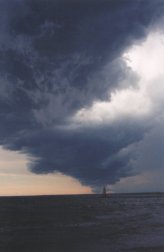 |
Monday, 4 August 1997
We struck lucky as it was the week of the EAA air show at
Oshkosh, which is a vast display of experimental
and enthusiastic aircraft. We cannot claim to be knowledgeable about private
aircraft but we watched with amazement when a Chevy pickup truck raced an
aircraft along the runway going from 0 to 300 miles an hour in 10 seconds. It
was a spectacular display as the two jet engines on the back of Chevy exploded
into life and flames hundreds of feet long shot out of the rear.
Valerie phoned Bev. and arrange for us to stay with them for a
few days next week. We have spent some time with the Coons (their
surname) in Mexico and Quartzsite.
George's day was made when he managed to fix a computer problem
which had been bugging him for some months
Tuesday, 5 - Wednesday, 6 August 1997
Before the bridge at Mackinac
was built in l957, the upper peninsula part of Michigan was pretty well
cut off from its state and even now has a sense of remoteness. It is a
peninsular 150 miles long and is squeezed between three of the Great Lakes -
Lake Superior,
Lake Huron
and
Lake Michigan.
We travelled along route 2 which follows the northern shoreline of
Lake
Michigan for most of its length.
It is impossible to exaggerate the immensity of the lakes - there are five in
total and they stretch 700 miles from top to bottom and 900 miles from east to
west. They cover 94,500 square miles making them almost the precise size of the
United Kingdom. Together they form the largest expanse of fresh water on earth
and are so large that you think that you are looking out to sea. The lakes are
served by many large rivers and countless creeks.
Numerous log cabin summer houses as well as a few
all-year-round homes are hidden along the tree-line shore, which occasionally
gives way to narrow sandy beaches on which a few people sunbathe. The water
temperature was too cold for us but some were brave enough to swim in the very
clear water. The area normally has about 200 inches of snow a year except when
it gets so cold that the lakes freeze, which pleases the locals since they do
not have to spend so much time clearing the snow. To us, it is strange to see
signs warning of snowmobiles and special parking areas for them, which gives
some idea of what it must be like in the winter.
One of the nicer campgrounds we stayed at was the J W Wells
State Park which was a very attractive area on the lakeside and which for some
reason appeared to attract several large orange butterflies (may have been
Monarchs)
Thursday, 7 - Friday, 8 August 1997
Travelling further east we saw several signs advertising
pasties and eventually decided to stop to sample one between us.
The pasties turned out to be the real thing brought to this
isolated corner of Michigan by nineteenth-century Cornishmen who came to work in the local mines. As with
most things over here they were extra large so one was more than
enough between us for lunch!
Saturday, 9 August 1997
We took the ferry from
St. Ignace to
Mackinac (MACK-i-naw) Island which lies in the Strait between Lake
Michigan and Lake Huron. The hydrofoil ferry was highly manoeuvrable
and extremely fast, blowing out a jet of water some fifty feet into the air, the
crossing in beautiful sunshine took about fifteen minutes.
The limestone outcrop island became a frontier outpost in
1780 when the English moved the old French garrison from the
mainland to the more strategic island. It remained the stronghold
of the Straits of Mackinac
for 115 years. The island is 3 miles long and 2 miles wide with
high cliffs fronting the shore and has ravines, natural bridges
and caves.
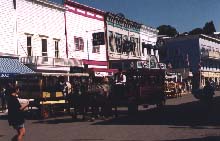 |
|
The only transportation on the island is by
horse-drawn carriage, bicycle or saddle horse; no motorised vehicles are
permitted, except for a public utility truck, a fire truck and an
ambulance. For this reason, SR 185, which rims the island, claims to be
the only state highway in the nation on which a motor vehicle accident
has never occurred. The flat SR 185 around the island perimeter makes a
cyclists paradise with literally thousands of rental bikes all over the
place, pedestrians need to take care of.
|
|
The major historical building is
Fort Mackinac which is on a bluff
overlooking the harbour, a restored 18th and 19th-century British and
American military outpost preserved as a museum. During our visit, we
watched several presentations by actors in historical costumes including
a re-enactment of a court martial.
|
|
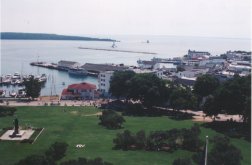 |
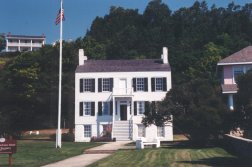 |
|
For a while, Mackinac was the biggest fur
trading post in the New World but its real glory dates from the late
nineteenth century when wealthy people from
Chicago
and Detroit came to escape the city heat and enjoy the pollen-free air.
The Grand Hotel, the biggest and oldest resort hotel in America was
built and the country's wealthiest industrialists constructed an ornate
summer house on the bluffs overlooking the village and
Lake
Huron. The houses are some of the grandest most elaborate ever
built of wood - twenty-bedroom places with every embellishment known to
the Victorians including towers, domes, gables turrets and large front
porches. All in all, visiting the island was an enjoyable and unique
experience.
|
Monday, 11 - Saturday, 16 August 1997
Bill & Bev. who we originally met in Mexico
had invited us to stay with them for a few days if we passed
through Michigan, so Monday found us yet again thankful
for the satellite navigation system as we drove to their place
via narrow and winding roads around the lakes near Gaylord.
| Their place is no more than a plot in the woods where
they stay in their motorhome for the summer and then like
so many other snowbirds flee the harsh winter of the
north and relocate to their other home in Florida. They
have electricity and phone hook-up but need to go to the
local campground about once a week for fresh water and
dump dirty water. |
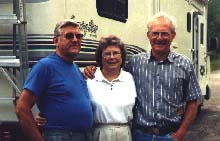 |
We stayed with them for five days during which they took us
on extensive tours of the lower
Michigan
peninsular, where we learned much about the area's history, geography, wildlife
and lifestyle.
Michigan's
prosperity has always been driven by the lumber trade which is not surprising
since over half the land area is covered by forest. This was made clearer when
we visited the Hartwick Pines State Park
where we learned that during the second half of the 1800s
Michigan produced more lumber
than any other state. Vast quantities of white pine were used to build houses,
barns and fences on the treeless great plains, while millions of board feet were
also consumed by the nation's rapidly expanding railroad system. The dollar
value was more than all the gold mined in
California during the same
period.
T
The park forest contains now rare examples of the original
magnificent old-growth giant pines which used to cover so much of the state. We
enjoyed walking through the silent forest and seeing numerous branchless white
and red pines growing straight up some 150 feet or so. It is easy to understand
why they were cut down in such vast numbers since they produced knot-less boards
up to thirty feet long by 18 inches wide. One particular pine had been stuck by
lighting which had left a deep scar in the bark down the trunk. It seems that
logging took place during the winter since the snow and ice made it easier to
haul the logs out of the forest to the riverside where they were stacked to
await being floated down the river when the spring thaw arrived. Conditions for
the lumberjacks must have been terrible with many being killed or injured or
dying from illness as most camps were far from medical assistance.
 |
|
We also visited a restored sawmill which was used
extensively to supply board for the settlement on
Mackinac in the 1790s. During
this period water driven power sawing was introduced which could cut up
to 200 boards a day compared to the 12 or so a day by two men in a saw
pit. It was interesting to see how ingenious the early settlers were, an
example being that 10-foot logs were sawn into boards except for about
the last two inches, in this way the boards could be more easily handled
and floated over to the island as one unit, once on the island the
boards were separated by cutting off the end of the log.
|
One evening after dinner at an old railroad depot, Bill
took us on a tour of the local countryside which is fairly flat and mainly
wooded terrain where we were surprised to see several herds of elk and numerous
deer in the fields. The bull elk were huge, and spend most of the time eating in
readiness for the winter to come. The area is a major source of Christmas trees
which somewhat disappointingly we learned, are helped to obtain the classic
conical shape by being machine trimmed when the tree is about two feet high. The
time with Bill & Bev. flew by and with Bill doing all the driving George broke a
many years old record by not driving for five days.
Saturday, 16 - Monday, 18 August 1997
As we needed to go to the Newmar factory to collect a
dinette chair to replace one damaged some months ago, we decided to go directly
to South Bend,
Indiana, which has a
campground with a modem-friendly adult lounge. So as Valerie expected, George
made the most of the opportunity to surf the net for several hours. On the way
to the campground, we had the heaviest rain we had experienced anywhere in the
US, which was followed later that evening by a tremendous storm which included,
according to the local TV, 20,000 lightning strikes as well as a tornado
warning. During the past week or so we have experienced more rain than during
our previous year of touring. Upon arriving at the factory we were pleased to
find that on this occasion Newmar appeared to have ordered the correct chair, it
was only when we got back to the RV did we find that it was about one inch
higher than the others, so George had to put the saw to good use.
Tuesday, 19 August 1997
With about a month before we need to be in West Virginia
for a rally, we decided to travel east to see Niagara
Falls and a little of the northeastern states. The I80/90 turnpike to
Geneva, OH was being repaired in several places
including the addition of about 10 new bridges crossing the road, which was
about the only item of note on the 290-mile journey. For the large part, the
Interstate follows
Lake Erie
which appeared to be fairly plain and uninteresting. We must remember however
that we did not stop and spend time staring, so the area may have more to offer
but in the main, the coastline did not have any beach as such, nor was there
anything facilities to temp a visitor. At the junction of the I80 and I90, lies
the large town of Cleveland which in its day must
have been a thriving industrial area, but today most of the facilities that we
saw were empty and run down.
Wednesday, 20 August 1997
The Kenisee campground at Geneva is located in a
wood overlooking several lakes mainly full of static trailers used as summer
homes. It's beginning to appear that a lot of the campgrounds in the northeast
states are older and less well-equipped than those in the south which is
probably partly due to the shorter season.
Ohio
claims to have more covered bridges than any other state most of which were
built around 1850. One of the best examples is the 150-foot-long bridge near
Geneva which like most was
largely built of wood, so roofs were added to prevent the roadway of the bridge
from getting wet and rotting. We met a fascinating local fisherman who also runs
a cafe at the side of the bridge just for the fun of it. He told us about the
trout runs which take place in April and October and little of the history of
the covered bridge. The whole area is very quiet so for the most part, it is
possible to fish all day long and not see a soul, (or sole)!
Thursday, 21 August 1997
The journey along the I90 to Niagara Falls took us
through the northern edge of Pennsylvania,
into
New York
State and then on to the town of
Niagara Falls,
which lies at the eastern end of
Lake Erie
and close to the Canadian border. There are two
Niagara Falls cities only a few miles apart, one in
Ontario,
Canada and the other in
Niagara Falls,
New York, being connected by a
bridge across the
Niagara River.
The river is a 37-mile strait that acts as a spillway, carrying drainage from
the four upper Great Lakes into
Lake Ontario. Among the
shortest rivers in the world at 36 miles, Niagara is also one of the wildest,
reaching speeds of 30 mph.
Niagara Falls were created by the recession
and melting of a mammoth ice sheet. As the ice retreated some
50,000 years ago the land rose behind it, forming such ridges as
the Niagara Escarpment.
The melting ice formed a vast lake in what is now Lake
Erie and its surrounding lowlands; the lake overflowed
about 12,000 years ago, creating Niagara Falls.
The falls were originally formed 7 miles north in what is now Lewiston and are still eroding towards
Lake Erie at the rate of one inch per year.
In the afternoon we visited the American side of the falls
which are higher than the Canadian at 184 feet but have a
shorter, fairly straight crest of about 1,075 feet.
|
The Canadian, or
Horseshoe Falls are 176 feet high with a deeply curving crest of
about 2,200 feet. We were amazed by the vast flow of water over the
falls and this was at the time of the year when water flow is below the
peak. The spray was rising several hundred feet into the air and with
the light wind, most of us got at least a little wet.
|
 |
Untouched, the combined flow of the water over the falls would
be about 1.5 million gallons per second; however, one-half to
three-quarters of the river is diverted for the generation of
electricity before it reaches the falls.
We watched the Maid of the
Mist boats full of tourists all donned in dark blue plastic coveralls
floating to the front of the falls, the boats looked somewhat puny against the
size of the falls. In the past it was the done thing to dive over the falls, the
first stuntster was Sam Patch. He survived two dives into the waters below the
falls. The first person to go over the falls in a barrel was Annie Taylor in
1901. William Fitzgerald took the plunge in 1961 and was arrested as soon as she
surfaced because stunts on the river and falls had by then been outlawed.
Friday, 22 August 1997
We crossed into Canada through the customs check on the
bridge and then in the pouring rain we explore the falls from the
Canadian side. The falls are impressive from the American side
but without any doubt the falls seen from the Canadian side are
more impressive, being wider in the shape of a vast horseshoe.
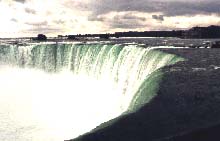 |
After absorbing the falls from the edge in the
falling rain for some time we went to have a coffee in a
tastefully designed restaurant overlooking the falls,
where we were able to continue watching the falls, since
no matter how long one looked one could continue to enjoy
the vastness. Lots of birds were circling the edge of the
drop looking for insects. |
One of the many tourist attractions is to take an elevator to the base of the
falls and then walk through man-made tunnels under the falls, so George donned
his Mae West and down he went. The tunnel traverses several hundred feet through
the rock parallel to the edge of the falls, the noise of the water flowing down
the face gives another reminder of the power of the falls. At several points,
openings have been made revealing vast swirling sheets of water roaring down and
yet another opportunity to get soaked. The falls can freeze in the winter to
around fifty feet thick, so ice booms are constructed upstream to prevent damage
downstream during the thaw. We were informed that more than 12 million people
visit the Canadian side annually, and more film is sold at the falls than
anywhere else in the world, we can now understand why.
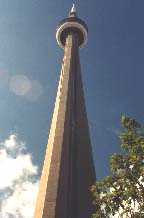 |
In heavy rain, we drove further into Canada
intending to explore parts of Toronto,
as it turned out we spent much of the afternoon visiting
the CN Tower which is
considered the tallest building and free-standing
structure in the world. It is 1815 feet to the tip of
the transmitter mast, and the revolving restaurant at 1150
feet is even higher than the tip of the Eiffel tower at
1049 feet.
It took the elevator only 58 breath-taking seconds
to whisk us up to the observation deck, which affords a panoramic view
of
Toronto.
|
| A section of the floor of the observation deck is
made of glass, it was fascinating to watch most of the
women very carefully walking around the glass section and
then peering over the edge, whereas children were happy
to lie on the glass and look down and then there were of
course, the teenage men who showed their bravery by
jumping up and down. |
 |
It seemed strange to be looking down onto what is normally
considered sky-scraping office blocks, but even the tallest is dwarfed by the
CN Tower.
Saturday, 23 August 1997
Yesterday, as we were returning from Toronto
the car's front brakes developed the typical noise indicative of
worn brake pads, so we were waiting outside the local brake
repair specialist when they opened at 07.30 as we wanted to move
on today. However even though we had been previously assured they
had the pads in stock, it was not so and the best they could
offer, after ringing the local stockists, was to order the pads
on Monday and fit them when they arrived which might be Tuesday
or later!
This challenge got George going who started ringing up all
the Suzuki dealers within a two-hundred-mile radius, however, it turned out most
were closed (Saturday - can this be America?) or the parts department was
closed, or they would need a week to obtain replacement pads as they were a
special item. However a call to the local Napa Auto Parts (similar to Halfords)
revealed that whilst they did not have any stock, they could obtain a set from
Buffalo, a town some 60 miles to the south within three hours - what service. So
after catching up on the Email during the morning we went to the Napa store
where the pads were waiting and then on to the fitters who confirmed to our
relief that they were the correct parts which were fitted within 15 minutes.
Sunday, 24 - Tuesday, 26 August 1997
After finishing washing the RV we travelled east 130 miles
along the I90 toll road to Cayuga Lake which is
one of 11 Finger Lakes, many of which are
lakes about fifty miles long and about a quarter of a mile wide lying mainly
north/south. American Indian folklore holds that the
Finger Lakes were formed when
God placed his handprint on some of the most beautiful lands ever created. We
drove the 100 miles or so around
Cayuga Lake
which had several wineries on the western side but found little else.
Our campground turned out to be along a very long, narrow
wooded track, which eventually opened into a sunny sloping field with a pleasant
walk to the lake. Most of our fellow campers seem to be in trailers which they
use as summer homes or weekend retreats. While having a cup of tea Valerie
noticed that water was dripping out of a trailer next to us, which seemed to be
odd since it had not been raining and nobody was using it. We asked the
campground owner, who calls himself The Mayor of Twin Oaks, to investigate who
found that the trailer was flooded which would have ruined most things including
dissolving the chipboard floor.
Wednesday, 27 August 1997
Overnight stop at the Turning Stone campground near
Verona, VT which was an almost new campground with
phone hook-ups which meant George could get a fix of net surfing.
Thursday, 28 - Sunday, 31 August 1997
For the first time since we started travelling the 1,500
miles or so east from Chicago the flat terrain has given way to hills
which we both prefer. We decided to move in the direction of
Boston, MA intending to stay
at Lake George on the route, however, we had
forgotten that this was the Labour Day weekend and after trying half a dozen
campgrounds we ended up booking into a campground at
Lake Bomoseen, VT. As
we half expected the local area was not very interesting and the campground
could only be described as acceptable. Labour Day is the last national holiday
in the summer period so everybody heads for the beach, parks or a long weekend
camping and boating. In no time the campground was full of groups eating masses
of food, including large steaks for breakfast and idling the time away chatting
around a campfire. Many of the northeastern states have countless lakes and
rivers so boating and fishing are major attractions, but without a boat, it is
difficult to see the lakes at their best since being heavily wooded countryside
with trees extending to the water's edge, most lakes are hidden from the road.
The car tag for Vermont is the
Green Mountain State with good reason since every hill is covered
in a wide variety of trees but the Maple dominates. Along the
roadside and in most built-up areas maple syrup is sold in a wide
variety of colours and flavours. It is produced by tapping the
tree in early spring and then the sap is boiled to remove about
70% of the water, the colour and sugar content is determined by
the amount of water removed during the boiling process. Real
maple syrup is delicious, it's difficult to say no to just one
more smothered pancake.
The local town of Rutland was
holding a state fair over the weekend, so we went to investigate. The fair was a
mixture of a traditional farming fair complete with cattle, chickens, equipment
etc. a country fair with prizes for the best vegetables (the prize-winning
pumpkin weighed 256lbs!) and flowers as well as a large fun fair. In addition, a
lot of excitement was being generated by the trotting races which took place
throughout the afternoon and then in the evening there was a demolition stock
car derby. It never ceases to amaze us but as always the major activity was
eating followed by more eating.
>>>









